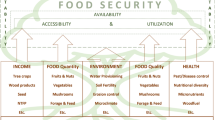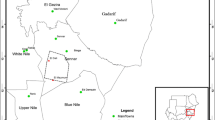Abstract
In recent years, there has been a growing realization that improving market access for smallholders will lead to improvement in income and food security. However, market failure often limit smallholders’ fair access to market opportunities. To address this problem, a market-oriented agroforestry action research program was implemented in six sites of Kavre and Lamjung districts of Nepal between 2013 and 2016. The main objective of this paper is to investigate the changing impacts of the market-oriented agroforestry system on improving people’s livelihoods and addressing food security issues. The net-margin analysis of five priority products of agroforestry systems indicated that farmers benefitted most by a banana-based high yielding fodder system (56%) followed by Alnus-cardamom system (48%), tomato-fodder and buffalo (36%), chilli-fodder (26%) and ginger-based (25%) systems due to facilitation of market-oriented agroforestry action research services. The impact of market-oriented agroforestry intervention from a survey of 289 households, revealed that household income was increased by 37–48%, which can provide up to six additional months of food to the poorest households. This innovation has the potential to take the majority of households (63%) out of the poverty cycle while avoiding food shortage during the year. The implications of the study are that farmers must be united for collective marketing of their production and develop marketing strategies to eliminate middle men for better return. Some key lessons learned for the success of this research include farmers’ own motivation, favorable environment, and the inclusion of social activities and incentives for cultivating priority products species.


Similar content being viewed by others
References
ADS (2015) Agriculture development strategy. Ministry of Agricultural Development, Kathmandu
Amatya SM, Pandit B, Ojha H, Cedamon E, Nuberg I, Shrestha K, and Paudel N (2017) A policy lab approach for reforming agro-forestry policy in Nepal, EnLiFT policy brief July 2017, EnLiFT Project, Kathmandu
Cedamon E, Nuberg I, Pandit B (2017a) Adaptation factors and futures of agroforestry systems in Mid-hills of Nepal. Agroforest Syst. https://doi.org/10.1007/s10457-017-0090-9
Cedamon E, Nuberg I, Shrestha K (2017b) How understanding of rural households’ diversity can inform agroforestry and community forestry programs in Nepal. Aust For 80(3):153–160. https://doi.org/10.1080/00049158.2017.1339237
DANIDA (2013) Business opportunities profile Nepal. Danida International Development Agency, Kathmandu
Duguma AL (2013) Financial analysis of agroforestry land uses and its implications for smallholder farmers livelihood improvement in Ethiopia. Agroforest Syst 87:217–231
FAO (2010) Assessment of food security and nutrition situation in Nepal (An input for the preparation of NMTPF for FAO in Nepal). Food and Agriculture Organization of the United Nations UN Complex, Pulchowk
FAO (2011) Market oriented advisory services in Asia: a review and lesson learned. Publishing Policy and Support Branch, Office of Knowledge Exchange, Research and Extension, Vialedelle Terme di Caracalla, Rome, Italy
Gilmour D (2011) Unlocking the wealth of forests for community development: commercializing products from community forests. 42 MindarieCres Wellington Point, Queensland, Australia
GON (2011) Central Bureau of statistics. Government of Nepal, Kathmandu
GON (2016) Economy of Nepal. https://en.wikipedia.org/wiki/Economy_of_Nepal. Accessed 08 Jan 2018
Gyau A, Franzel S, Chiatoh M, Nimino G, Owusu K (2014) Collective action to improve market access for smallholder producers of agroforestry products: key lessons learned with insights from Cameroon’s experience. Sci Direct. https://doi.org/10.1016/j.cosust.3.10.017
ICRAF (2014) Commodity selection matrix. World Agroforestry Center, Bagor
MOAD (2015) Agriculture development strategy of Nepal. Ministry of Agriculture Development, Singha Durbar, Kathmandu, p 104
NAF(2013) Qualitative baseline assessment of Agroforestry System in Kavre and Lamjung Districts of Nepal. Koteswor, Kathmandu- EnLIFT research series
Neupane RP, Thapa G (2001) Impact of agroforestry intervention on farm income under the subsistence farming system of the middle hills, Nepal. Agrofor Syst 53(1):31–37
NLSS (2013) Report of Nepal living standard survey. Government of Nepal, Kathmandu
Pandit BH, Albano A, Kumar C (2009) Community-based forest enterprises in Nepal: an analysis of their role in increasing income benefits to the poor. Small Scale For. https://doi.org/10.1007/s11842-009-9094-2
Pandit BH, Shrestha K, Bhattarai S (2015) Sustainable local livelihoods through enhancing agroforestry systems in Nepal. J For Livelihoods 12(1):35–51
Paudel KP, Tamang S, Shrestha K (2014a) Transforming land and livelihood: analysis of agricultural land abandonment in the mid hills of Nepal. J For Livelihoods 12(1):11–19
Paudel K, Subedi YR, Tamang S, Nuberg I, Shrestha K (2014b) Milestones in selecting field sites for participatory action research, research paper series on agroforestry and community forestry in Nepal, pp 1–56
Rasul G, Choudhary D, Pandit B, Kollmair M (2012) Poverty and livelihood impacts of a medicinal and aromatic plants project in India and Nepal: an assessment. Mt Res Dev 32(2):137–148
Shrestha AJ, Pandit B (2017) Action research into a flood resilient value chain—biochar-based organic fertilizer doubles productivity of pea in Udayapur, Nepal. Am J Agric For 5(4):84–93
Strange R (2013) Alerts for policy makers extracted from papers published during 2012 in volume 4 of food security. Food Sec 5:9–11
Valdivia C, Barbieri C, Michael A (2012) between forestry and farming: policy and environmental implications of the barriers to Agroforestry adoption. Can J Agric Econ 60:155–175
Acknowledgements
The Enhancing Livelihoods and Food Security through Agroforestry and Community forestry (EnLiFT Project http://forestaction.org/enlift/) was implemented under a collaborative arrangement between 10 different organizations in Nepal and aboard, and was funded by Australian Centre for International Agricultural Research (ACIAR).
Author information
Authors and Affiliations
Corresponding author
Rights and permissions
About this article
Cite this article
Pandit, B.H., Nuberg, I., Shrestha, K.K. et al. Impacts of market-oriented agroforestry on farm income and food security: insights from Kavre and Lamjung districts of Nepal. Agroforest Syst 93, 1593–1604 (2019). https://doi.org/10.1007/s10457-018-0273-z
Received:
Accepted:
Published:
Issue Date:
DOI: https://doi.org/10.1007/s10457-018-0273-z




